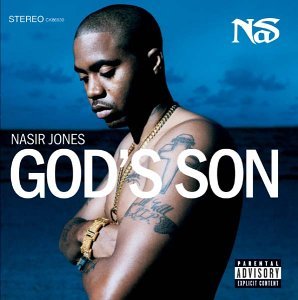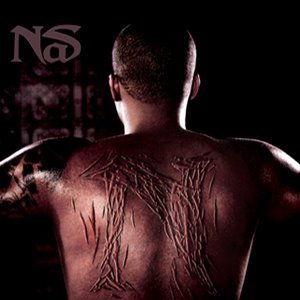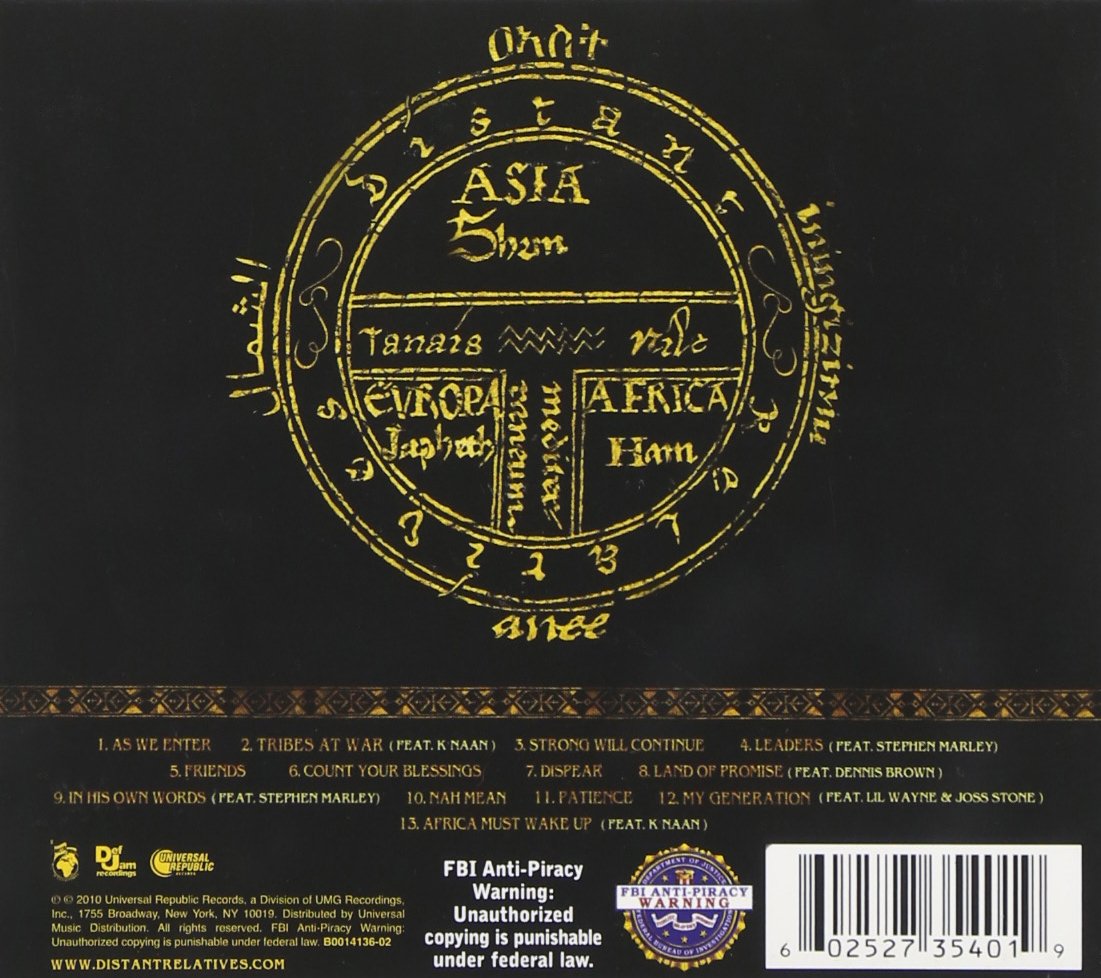ILLMATIC to IT WAS WRITTEN to I AM to NASTRADAMUS
We all know the "boy" to "man" to "king" to "prophet" progression that runs parallel with Nas' first four albums, i.e.
Illmatic to
It Was Written to
I Am to
Nastradamus. Showing Nas growing as a man and as an artist, his first four albums, and the covers that accompany them, are rather basic in design: 1) Building 4013 in the QB projects, a young poet cut against the backdrop of his Queens borough 2) The project mentality still there, but now grown, a chain and watch examples of the floss the Escobar lifestyle would require 3) Queens still popping up in the back, but mostly pushed aside in favor of the egocentric and gaudy Egyptian pharaoh artwork, Nas the king of a post-BIG NYC. 4) Finally, the so-called prophet of
Nastradamus, a harbinger of what would be to come.
The cover of
Nastradamus sets up the cover of
Stillmatic in an interesting way. It's Nas' fourth album, and he's prophesizing. He's not saying, "this is the end result, this is the top." He's saying, "there's more to come, a turbulent future lies ahead."
Stillmatic would be that album, immersed in conflict, political in its post-9/11 commentary, political in the world of Hip-Hop with the Jay-Z, Cormega, Nature, Prodigy beefs, and personal with the split from his baby's mother. Hinting at it on
Come Get Me, one can assume that during the time of
Nastradamus, Nas knew his running feud with Jay-Z would one day become public. Then, with QB rappers often at odds with each other, he probably also saw where his hood was heading and knew
Destroy & Rebuild was imminent. The last line of the
Nastradamus LP, from poet Jessica Care Moore's piece The Outcome,
"despite the damage to destiny you can't take the best of me - In God we still trust", thematically sets off Nas' next albums. The "damage to destiny" occurs in
Stillmatic, and the promise of "In God we still trust" can be found in the spirituality Nas embraces with
God's Son.
STILLMATIC
Simply put, the cover of
Stillmatic showcases the downfall of man. It references Nas' artistic downfall, personal trepidations, and the injury done to man in the greater world. It's 9/11, hyper urbanization, crime, racism, poverty, drugs, death, and the rap game Nas plans to destroy and rebuild,
"hate to cease y'all plan - it's the rap repo man."
In an interview around the time of
Stillmatic's release, Nas reported that for the cover shot he wore just about every piece of jewelry he owned. We see his QB medallion, a host of platinum necklaces, some diamond rings, and an iced out watch. This is the folly of Nas (his Escobar flossing days), the excess of the rap game (The Big Willy / Jiggy / Bling era) and, more metaphorically, the indulgence of a capitalistic American society (think the inflated economy of the late 90s). The garish orange jump suit Nas wears is intentionally loud. The visually offensive display is a purposeful act of irony.
Behind all that platinum, the dark, lightning scorched skies above the NYC skyline represent the apocalyptic world prophesized on
Nastradamus. The omission of the twin towers in the skyline is a direct reference to 9/11. The water is very important as well, but I'll get to that in a minute . . .
One of the most interesting aspects of this scene is the pigeon, the ghetto dove, the only presence on the same perspective level with Nas. This is where it gets biblical. (The link to the Judeo-Christian religion is established with the silver cross that hangs conspicuously below the rest of Nas' jewelry.) Taken as a whole, the entire album cover is an allusion to the
Old Testament story of
Noah. Y'all know it, but, if you don't, here's a recap. In ancient times, mankind had become very wicked. Murder and rape abounded, immorality everywhere. In response, God punished the wicked of the world with a flood. The
Stillmatic cover is that moment before the flood. Nas is at once Noah and God, poised for what's ahead and ready to see it through.
Stillmatic is Nas' ark, and just as Noah brought himself, his family, and two of every animal to repopulate the world, the 2001 LP, with his little girl even credited as executive producer, was Nas' vessel to carry his own musical family (Large Professor, DJ Premier, LES, The Trackmasters, AZ, QB associates) on to repopulate the rap world after it had been destroyed.
Back to the pigeon. In the Bible, Noah sent out a dove everyday during the flood. The dove would continually return with an empty beak, representing that there was no land and that God's punishment was still in effect. The pigeon stands as Nas' dove ready to be sent out pending the coming storm. Notice those rain clouds overhead are holding a lot of water, the lightning carries the promise of a storm.
GOD’S SON
Fast forward to 2002. In contrast to the chaotic front of
Stillmatic, we have a tranquil, minimalist cover for
God's Son. Nas is surrounded by water. The sky and water are both dark blue, hinting at a departing storm. The world has been flooded. The storm hit during
Stillmatic, and the water that loomed in the background of that cover has now risen and engulfed the buildings, the wall and Nas himself. Nas stands arms folded, head down, in reverence. In mourning for the loss the storm has brought, and for the loss of his mother, he's humbled. He is also in prayer to God. As
Stillmatic was the ark,
God's Son is Nas' personal meditation and communication with God.
As the earlier orange velour get-up has been washed aside, Nas now stands unclothed. And except for a covered Jesus piece and a single golden bracelet, the storm has swept away most of the previously photographed jewelry. Nas is bare because he is now naked of sin. On the surface, no more orange jump suit, no more platinum, the self-indulgence kept to a minimum. Musically, within the disc, his style of rap turns down much of the materialism of his past,
"I live a clean life - I don't even steal cable." He is no longer the kingpin, the king, the prophet or the hell raiser. He is a spiritual disciple of the streets, a survivor of his own storm.
On the back cover, we see Nas' arms outstretched. In his hands sit two doves, contrasting with the single
Stillmatic pigeon. In a sense, Nas and his bird friends are the same. Nas' style transcended from a gritty street aesthetic to the spiritual purity of
God's Son, a similar difference seen in the progression from pigeon to dove. And as there are
two doves on the LP back, one in either hand, Nas appears balanced, the second dove evening out the first. 2001 was a shaky time as far as the rapper's future in the game was concerned, but, come 2002, stability seemed to have set in, the storm endured.
STREET'S DISCIPLE
The
Stillmatic-God's Son trinity is completed with
Street's Disciple. For this, I'm going to refer to the extended cover featuring King Nas and the full 12 Nas disciples. This is the poster that was included in the
Street's Disciple CD case. The actual CD cover shows only a fraction of the larger image.
The cover is grand in its scope and implications. We are in the interior of a stone building with vaulted arches. A single light illuminates the room. This light represents the holy father shining down, the cross above it strengthening the symbolism. Beneath, thirteen variations of Nas are gathered around a table, some sitting, some standing. One is enthroned in the center. He is King Nas, the Nas of
Street's Disciple. The other twelve are his various alter egos and personas, twelve disciples that all make up Nas. Around them we find plenty of drink, grapes, oranges, and bread. However, of all the pieces in this tableau, a piece of cake, situated slightly to the left and in front of Nas, remains the most curious.
The piece of cake is a generous portion, fit for a king, you might even say, and there is something written on it. Upon first examination, the letters appear to read "Nas", but, if one looks closer--visible especially on the poster--it's not "N-A-S". There's no "A", and what looked like an "N" is really the Greek lowercase letter
Eta, "η", and what looked like an "S" is actually the Greek uppercase letter
Omega, "Ù".
In astronomy, which Nas has referenced throughout his career,
Eta symbolizes the seventh brightest star in a constellation, and it also is the seventh letter of the Greek alphabet. Without going into too much detail, Level 7 corresponds to the highest possible level of consciousness in almost all spiritual belief systems; Supreme Mathematics, Theosophy, Buddhism, and even Christianity and Islam have variations of this. Specifically in Supreme Mathematics, known as well as
The Nation of Gods and Earths, which Nas has also referenced throughout his career, the number seven itself is important because it stands for perfection (the seventh letter in the English language alphabet, "G", standing for "God"). With this reading, the
Eta on the cake slice represents Level 7, perfection, the supreme level of consciousness. In other words, it's pure being, the height of creativity, the most total understanding.
Then, as many know,
Omega is akin to finality, the end. So being that
Omega designates the end, a pairing of
Eta and
Omega reads "Level 7 - The End", i.e., in a highly coded statement, the cake says this: Nas has reached the highest point of the rap art form. After him there is nothing, for there is nothing above
Eta, Level 7.
Omega serves as the period at the end of the sentence. Extrapolating this out, the cake slice represents the
Street's Disciple album as being an example of the most evolved rap form, its greatest maturation. Finally note how the cake is missing a side, some piece already eaten. We can assume that the King Nas figure, who it sits in front of, has eaten it, its message now inside, a part of him, and, through the music, conveyed to the listener.
Nas: Mastermind
Nas: Stillmatic Intro
Nas f/ Jessica Care More: The Outcome
*NOTE: Stu -- Top Dude all on this one. Thanks.--Fletch































 I love Nas but we all know he’s a big smoker and says a lot of stuff but doesn’t always follow through. Or maybe it was intention to do it all but changed his mind or changed the concept a bit.
I love Nas but we all know he’s a big smoker and says a lot of stuff but doesn’t always follow through. Or maybe it was intention to do it all but changed his mind or changed the concept a bit.



